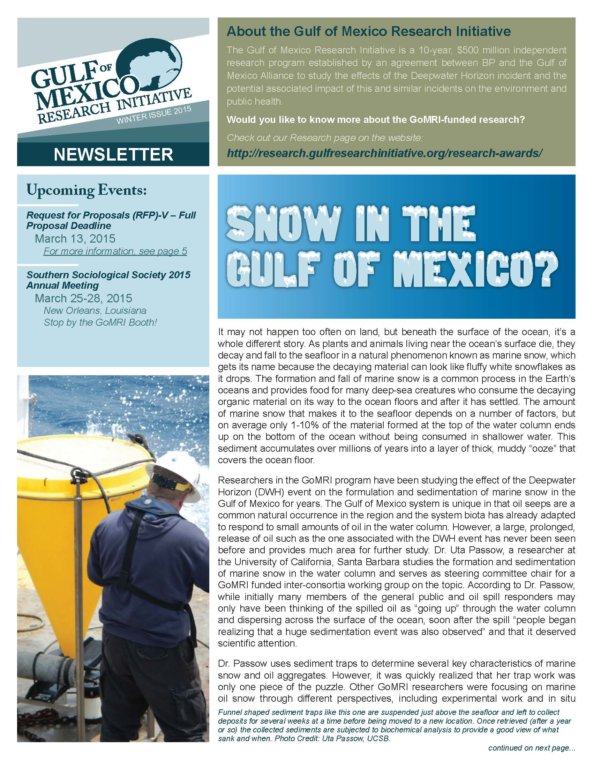GoMRI Newsletter: Winter Issue 2015
Download Full Issue (PDF)
 Above the Fold
Above the Fold
– “Snow in the Gulf of Mexico”
– “New Consortia!”
– “Mesocosm Experiments Look at Oil Spills from the Bottom Up”
– “Presence for GoMRI Researchers at the 2014 International Oil Spill Conference”
– Frequently Asked Questions by Dr. Chuck Wilson
– Note from the Research Board Chair
– Education Spotlight
– GoMRI Researcher Interview with Dr. Irv Mendelssohn
Community Happenings
Science Corner
Published Science Highlights from the GoMRI Program
Study Identifies Efficient Food-Grade Emulsifier as Dispersant Alternative
J.C. Athas, K. Jun, C. McCafferty, O. Owoseni, V.T. John, and S.R. Raghavan
Langmuir, 2014, 30 (31), 9285-9294
Study Shows Drifter Data on Surface Currents Critical to Predict Pollutant Transport
A.C. Poje, T.M. Özgökmen, B. Lipphardt, Jr., B.K. Haus, E.H. Ryan, A.C. Haza, G. Jacobs, A.J.H.M. Reniers, J. Olascoaga, G. Novelli, A. Griffa, F.J. BeronVera, S. Chen, P. Hogan, E. Coelho, A.D. Kirwan, Jr., H. Huntley, and A.J. Mariano.
Proceedings of the National Academy of Sciences of the United States of America, 2014, 111(35),12693-12698
Study Shows Bursting Bubbles Can Redistribute Oil Droplets into a Water Column
J. Feng, M. Roché, D. Vigolo, L.N. Arnaudov, S.D. Stoyanov, T.D. Gurkov, G.G. Tsutsumanova, and H.A. Stone
Nature Physics, 2014, 10, 606-612
Study Estimates Decades-Long Persistence of Harmful Hydrocarbons in Marshes
R.E. Turner, E.B. Overton, B.M. Meyer, M.S. Miles, and L. Hooper-Bui
Marine Pollution Bulletin, 2014, 86 (1-2), 291-297
Study Identifies Highly-Efficient Methane-Eating Microbe Present after Oil Spill
M. Crespo-Medina, C.D. Meile, K.S. Hunter, A-R. Diercks, V.L. Asper, V.J. Orphan, P.L. Tavormina, L.M. Nigro, J.J. Battles, J.P. Chanton, A.M. Shiller, D-J. Joung, R.M.W. Amon, A. Bracco, J.P. Montoya, T.A. Villareal, A.M. Wood and S.B. Joye
Nature Geoscience Letters, 2014, 7, 423-427
To see all GoMRI publications, please visit the GoMRI Publication Database.
Video Clip of the Quarter
Check out this video showing how the use of drones during the Surfzone Coastal Oil Pathways Experiment (SCOPE) helped scientists from CARTHE study how oil moves from offshore onto our beaches! Using drones is an innovative approach to a complex problem with powerful results.
The video can be seen here and a blog post about the experiment can be found here.
GoMRI Newsmakers
Congratulations to the following member of the GoMRI community!
Congratulations go out to Dr. Samantha “Mandy” Joye, on her selection as an American Association for the Advancement of Science (AAAS) Fellow. Mandy Joye is a microbial geochemist with the University of Georgia and a lead scientist for the GoMRI-funded Ecosystem Impacts of Oil and Gas Inputs to the Gulf (ECOGIG) consortium. She is also the Principal Investigator of a recently-awarded GoMRI grant to continue this research. Joye’s expertise lies in quantifying rates of microbial hydrocarbon metabolism and environmental geochemical signatures in natural environments. She has studied Gulf of Mexico natural seeps for 20 years and has tracked the environmental fate of oil and gas released from the Macondo well blowout since May 2010.
GoMRI Scholars in Action
The Gulf of Mexico Research Initiative (GoMRI) is recognizing the graduate students whose vital research contribute to improve understanding about the damage, response, and recovery following the Deepwater Horizon oil spill. Candidates for this program must be graduate students who have participated in a GoMRI-funded project for at least one year, whose work is primarily funded by GoMRI, and who are working on a dissertation or thesis based on GoMRI-funded science.
Learn more about the scholars’ research and career paths on the GoMRI Website:
- Grad Student Dannenberg is Unlocking Mysteries of Deepwater Coral Communities
- Grad Student Chen Knows Ants Are More Than Just Bugs – They’re Oil Detectors!
- Grad Student Li Creates Waves for Oil Dispersion Studies
- Grad Student Laxague is Making Waves Using Sea-surface Ripples to Detect Oil
- Grad Student Christiansen’s Preemptive Research Enhances Galveston Bay Spill Response
Ocean Portal
Smithsonian Features Blog by Caroline Johansen on Deep Sea Oil Seeps
There can be catastrophic results when a large amount of oil is spilled into the ocean, but did you know that many marine organisms need a little bit of oil to survive?
The Smithsonian Ocean Portal posted a guest blog by Caroline Johansen explaining how natural oil and gas seeps from the ocean floor act as a source of energy for bacteria.
Read Johansen’s Ocean Portal blog.
2015 Gulf of Mexico Oil Spill & Ecosystem Science Conference Wrap-Up
More than 1000 people from 21 countries participated in the annual conference to discuss research associated with the Deepwater Horizon oil spill of 2010. The conference included approximately 270 oral presentations and 230 posters, plenary sessions, and many other associated events through the week. Abstracts from the presenting scientists can be viewed online here. And an official conference report will be made available on the conference website in the near future.
